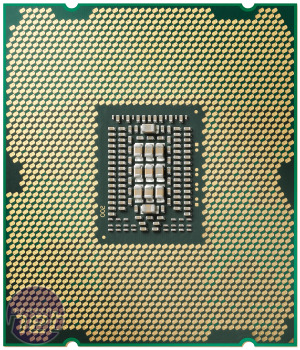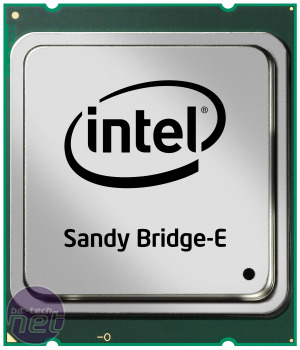Intel Core i7-3930K Review
Manufacturer: IntelUK price (as reviewed): £479 inc VAT
US price (as reviewed): $600 (ex tax)
In the past, one of the biggest reasons for buying an Extreme Edition processor was for the unlocked CPU multiplier which made them very overclockable. However, in a stunningly confusing move, both of the first two Sandy Bridge E CPUs have an unlocked CPU multipliers. However, the Core i7-3960X Extreme Edition has an extra 3MB of Level 3 cache and another 100MHz of nominal and Turbo Boost frequency to justify it's Extreme Edition price.
The more modest Core i7-3930K costs £479 rather than £839, and with six physical cores (plus Hyper-Threading for another six logical cores) and a healthy 12MB of Level 3 cache, is a more reasonable purchase on paper. The third LGA2011 that we know about - the Core i7-3820 - is a quad-core CPU, and what's the point of buying a pricey LGA2011 motherboard and quad-channel RAM just to put a jumped up i7-2600K in it?
Consumer application performance
Like the Core i7-3960X Extreme Edition, the i7-3930K achieved a very fast score in our heavily multi-threaded video encoding test, but failed to impress in the less intensively threaded image editing and multi-tasking tests.This means that the i7-3930K could only manage an overall score of 2,252 in our Media Benchmarks, just 2 per cent higher than the quad-core i7-2600K. The simple fact of the matter is that most consumer applications aren't coded to run across 12 threads.
Gaming performance
While many games developers are happy to take advantage of the advanced rendering power of modern GPUs, there are very few games that run faster on anything more sophisticated than a quad-core CPU. We only know a few with more than four threads (Arma II and Shogun 2 to name a couple).Therefore, it should come as no surprise that the i7-3930K failed to match the frame rate of its higher frequency quad-core Sandy Bridge sibblings in Arma II: Operation Arrowhead. However, the i7-3930K did perform very well in Shogun 2: Total War, with an 11 per cent faster frame rate than the i7-2600K.
Professional application performance
As the i7-3930K has such similar specifications as the i7-3960X Extreme Edition it also performed very similarly in professional applications. For example, in Cinebench R11.5 the i7-3930K scored 10.15, which is just 10 per cent slower than the i7-3960X.The CFD (Computational Fluid Dynamics) benchmark Euler3D told a similar tale, with the i7-3930K managing a score only 8 per cent slower than the i7-3960X. The i7-3930K was once again just 8 per cent slower than the i7-3960X in FlamMap, just 11 per cent slower in LightWave 9.6 and just 14 per cent slower in Terragen 2.
Overclocking
As we could only overclock the i7-3960X from 3.3GHz to 4.7GHz we were expecting that the 3.2GHz i7-3930K would only overclock to around 4.5GHz. After all, part of the sales message of Extreme Edition processors is that they are cherry-picked CPUs that should overclock better than standard processors.However, the i7-3930K has identical overclocking properties as the Extreme Edition CPU. Using a CPU voltage of 1.4V, a CPU multiplier of 38x, a Base Clock of 123.75MHz, a CPU strap of 125MHz and a memory speed of 1.98GHz, we could also run the i7-3930K stably at 4.7GHz.
This overclock provided a substantial boost in performance in every test, allowing the i7-3930K to extend its lead over every other CPU bar the i7-3960X Extreme Edition. This is because the latter has 15MB, as opposed to 12MB, of Level 3 cache. However, when both Sandy Bridge E processors were overclocked, there wasn't much difference in performance. In our Media Benchmarks, for example, the i7-3930K was less than 0.2 per cent slower than the i7-3960X.
Power efficiency
The i7-3930K is a fair bit more frugal with its power consumption than the i7-3960X, drawing a noticable 47W less when idle and 37W less under load. Another interesting comparison is with the i7-3930Ks immediate predecesor, the Core i7-990X Extreme Edition, which drew 11W more under load and yet is around 10 per cent slower in most benchmarks.However, the i7-3930K does guzzle electricty when overclocked: a hideous 525W under load. In comparison, the i7-990X drew just 423W when overclocked. This is due to the much higher voltages that the Sandy Bridge E chips require when running overclocked.
Conclusion
While we don't want to give the impression that the i7-3930K is a slow CPU for consumer applications and games, it isn't significantly faster than the Core i7-2600K. This is a problem for Intel, as the i7-3930K is almost exactly double the price; LGA2011 motherboards cost roughly twice as much as LGA1155 boards and you need to add twice as many memory sticks. The foundations of an LGA2011 system could easily cost you twice as much as a LGA1155 PC, and yet won't deliver tangible amounts of extra performance unless you use n-threaded, professional-level applications.As such, and combined with its high power draw, we simply can't recommend the i7-3930K to most of our readers. Gamers in particular should steer well clear of the Sandy Bridge E processors - if you're desperate to spend cash, put it toward a SATA 6Gbps SSD. This is guaranteed to make your PC faster and more responsive than an over-specced CPU.
We started off this review pondering what the 'E' in Sandy Bridge E stood for and we're now fairly convinced that it doesn't stand for 'Extreme' or 'Enthusiast'. Instead, it must mean 'Enterprise' because most professional-level applications are able to address the 12 execution units of Sandy Bridge E processors. In Cinebench R11.5, for example, the i7-3930K was a magnificent 36 per cent faster than the quad-core, Hyper-Threaded i7-2600K.
The i7-3930K is so fast when overclocked, it also provides a serious alternative choice to a dual-processor workstation. Using Cinebench R11.5 as an example again, the overclocked i7-3930K was less than 1 per cent slower than a pair of Xeon X5650s, a combination that would set you back at least £1,100 more. However, you'll need powerful cooling to tame the heat of the CPU and its VRMs - water-cooling would be our choice for both. Only the ECC registered memory of a Xeon-based system makes them worth considering.
Ultimately, while we're disappointed by the performance and limited overclockability of both Sandy Bridge E processors, its clear that the i7-3930K is by far the superior of the two. At stock speeds it's not that much slower than the far more expensive i7-3960X, and when overclocked the two chips performance is indistinguishable. However, we would hold out for Ivy Bridge E (due this time next year) if you've already got a Gulftown system. Meanwhile, gamers and general-use PCs should stick to LGA1155 setups as these will deliver most of the performance for much less outlay.
Intel Core i7-3930K Specifications
- Frequency 3.2GHz
- Turbo Boost Frequency up to 3.8GHz
- Core Sandy Bridge E
- Manufacturing process 32nm
- Number of cores six physical, six logical
- Memory controller Quad-channel DDR3
- Cache L1: 32KB + 32KB (each core), L2: 256KB (each core), L3: 12MB (shared)
- Packaging LGA2011
- Thermal Design Power (TDP 130W
- Features SSE, SSE2, SSE3, SSSE3, SSE4, SSE4.2, EM64T, EIST, Execute Disable Bit, VT, AES-NI, Turbo Boost 2.0, AVX

-
Value21 / 35
-
Features9 / 15
-
Speed47 / 50


MSI MPG Velox 100R Chassis Review
October 14 2021 | 15:04











Want to comment? Please log in.